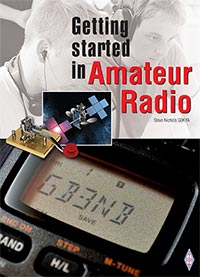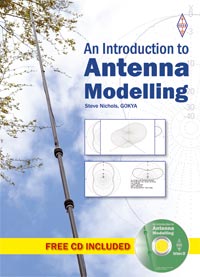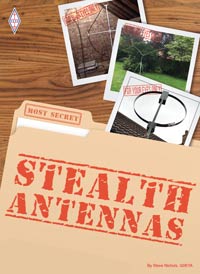
This is one of my favourite, cheap antennas. I have been using one for years and they don’t get much simpler.
Mine was catapulted over the roof at this QTH. It goes out of the ground-floor shack window, straight up, over the roof and then down to the end of the garden where it is tied off with fishing line, leaving the end about 10 ft high. The counterpoise goes off at 90 degrees (see illustration).
At the last QTH it went 50ft up into an oak tree. It is very stealthy and a firm favourite of the QRP fraternity.
It consists of an 85ft wire fed against a 17ft counterpoise. Some books say that you don’t use the counterpoise at all on 10m. Others say that you use a 6.5ft counterpoise on 20m. You do need an ATU though.
Some even say that you should feed it as a balanced antenna through a balun, rather than as an end fed with the counterpoise connected to the earth terminal.
I have tried it both ways and it seems to work either way. The tuning is slightly twitchier using it as a balanced antenna.
The antenna works well on 80m and 40m and even gives a dipole a run for its money on 20m. I am writing this as I listen to US stations on 20m and Californian and Michigan stations are actually slightly louder on the W3EDP rather than the 20m dipole.
DX worked on this £5 wonder include 6W/DL4JS Senegal, YK9G Syria, VQ5XF Turks and Caicos, VP6DX Ducie Island and VQ9JC Diego Garcia.
The downside of the W3EDP is that it can be noisier than a dipole and watch for RF in the shack. Running it with an earth wire to a stake and a counterpoise my field strength meter shows that it isn’t too bad though. Try one.
Mine was catapulted over the roof at this QTH. It goes out of the ground-floor shack window, straight up, over the roof and then down to the end of the garden where it is tied off with fishing line, leaving the end about 10 ft high. The counterpoise goes off at 90 degrees (see illustration).
At the last QTH it went 50ft up into an oak tree. It is very stealthy and a firm favourite of the QRP fraternity.
It consists of an 85ft wire fed against a 17ft counterpoise. Some books say that you don’t use the counterpoise at all on 10m. Others say that you use a 6.5ft counterpoise on 20m. You do need an ATU though.
Some even say that you should feed it as a balanced antenna through a balun, rather than as an end fed with the counterpoise connected to the earth terminal.
I have tried it both ways and it seems to work either way. The tuning is slightly twitchier using it as a balanced antenna.
The antenna works well on 80m and 40m and even gives a dipole a run for its money on 20m. I am writing this as I listen to US stations on 20m and Californian and Michigan stations are actually slightly louder on the W3EDP rather than the 20m dipole.
DX worked on this £5 wonder include 6W/DL4JS Senegal, YK9G Syria, VQ5XF Turks and Caicos, VP6DX Ducie Island and VQ9JC Diego Garcia.
The downside of the W3EDP is that it can be noisier than a dipole and watch for RF in the shack. Running it with an earth wire to a stake and a counterpoise my field strength meter shows that it isn’t too bad though. Try one.













"Running it with an earth wire to a stake and a counterpoise my field strength meter shows that it isn’t too bad though."
ReplyDeleteHi Steve, I have your antenna book and because of that built the W3EDP, and its allowed me to get on multiple bands for the first time, and keep the wife happy (its less intrusive than a dipole in the middle of the garden).
But I have one question - to what connection do I put that earth stake? I'm using a tuner of course, and the GND of that is connected to the 17ft counterpoise. Does the earth line go there? Or to the transmitters earth?
all the best
Scott M6OZI scottnjill2004@btinternet.com
awesome post! Here's how I did my W3EDP http://vurl.me/BECK. I reference your article. I would be interested in your NEC2 file if you have one for the antenna model you created. I did a couple of models, but was unsure if I was correctly 'feeding' the antenna. Also check out the link to an email on QRP-L from 1998 about the W3EDP. Could help you explain the 'rf in the shack' from the 'counterpoise' (hint, it's not a counterpoise!) ;)
ReplyDeleteI tried using your website for giving my views, but it refused to recognise my URL, probably because I am not familiar with the procedure and I don’t know what an URL is. I don’t have a website. Anyway, here is my two pennyworth.
ReplyDeleteThe “magic length” of 85 feet can also be used effectively for a doublet. Half the length of the top plus one leg of the feeder equals 85 feet, taking into account the velocity factor of the feeder, which should be parallel feed, such as 300 ohm ribbon or open wire.
My top is 102 feet and the 300 ohm feeder 30 feet. It tunes up easily on 80, 40 and 20 metres with a T match ATU. Obviously, no counterpoise is needed with this balanced antenna.
Best wishes,
Derek Love. G0DRA
Great ideas to play with on my West Africa trips. I have a T match ATU. Will experiment a bit with that.
ReplyDeleteAnother way to build the W3EDP is the classical way and treat it as a Zepp Antenna with a 66ft radiating section and 17ft feeder (Open wire or Ribbon). A balanced AMU is best for this method. So far I’ve used it more or less as G0KYA has described with the 17ft counterpoise with the balanced AMU as described. It’s always worked well for me. However, my next one will be the ‘classical’ version at a height of around 27ft, this method intrigues me and I will be erecting it in early January 2019. If you can imagine 17ft of Open wire feeder and then a single wire attached to one of the feeder wires leading upwards for another 10ft, that will be the vertical section. The other feeder wire acts as the 17ft counterpoise. The horizontal section comprising of 57ft of wire will then make up the antenna. It will be connected to the ‘balanced feeder terminal’ of my Z match AMU. There will be a certain amount of radiation from the feeder, this has never posed a problem with my previous versions.
ReplyDeleteI read your blog post and as I was looking for a wire antenna at my new QTH and had just 85ft from the apex of the house roof to a tree in the garden. I'd considered a W3EDP before but my previous QTH lent itself to Doublets better. I've had this up a couple of weeks now as 85ft top with a 17ft counterpoise using old fashioned 450 ohm ladder line and effectively Zepp feeding. It tunes up from 160M to 6M although my CapCo SPC tuner is flat out on 160. It's up at 30 feet and sits over a valley leading to the sea. Conditions have been ropey recently but I've been heard in VK4 on 40 at 1700 and worked lots of EU with QRP. I've even been on 80M CW for the first time for a few decades. Well recommended antenna from a real 1930s US Ham contemporary with Windom. I have a photo of G6FUs shack in 1934 and W3EDPs QSL is on his wall!! 73 de G4GZG.
ReplyDeleteSo impressed with this antenna, been meaning to upgrade, but it would be a huge cost for little improvement. My thick coax comes out of the shack, and straight up to my mast. The balun is fixed just 1m below a spinning wind turbine! with the 84 feet of wire going up my garden above the hedge line at an average height of 5m above ground. In the other direction my 17 feet of wire is not quite so high, more angled down. But I'm chatting to every direction with just 45W. From central UK, I've spoken to North African, South America, Texas USA, Ukraine, Mosco, St Petersburg, Stockholm.
ReplyDeleteI put one of these up a few years ago while I was trying to decide how to build an OCFD. In my version, the 17' of ladder line is joined at the bottom and connected to an SG230 auto tuner. I have tried with and without the counterpoise but could not see much difference. It tunes all bands, including some parts of 160m and I have managed some reasonable DX. The tuner is connected into the shack with RG-213 coax (about 70'). Anyway, it's still up - I never did build the OCFD. 73 Ken M1SLH
ReplyDeleteI just found this thread and wanted to chime in. End fed wire details are also on the U of Delaware website https://udel.edu/~mm/ham/randomWire. I use 85 feet of 14ga wire connected to a 9:1 UNUN. I've run the wire either horizontal with the UNUN at 40ft up (about 42 ft of coax back to an arrestor with no counterpoise off the UNUN), or as an inverted L with the UNUN at 2ft, wire straight up to 40ft, then horizontal to a far tree. This one only has 4ft of coax to the arrestor but has a counterpoise off the UNUN connected to a metal hose bib on the house which connects to long runs of copper pipe. This antenna is bit noisier than others, but it will tune 160m-6m. I've made contacts out to 5000+ miles from Maryland on 100W (or less on FT8), and even many states and a few countries on 160m. I think this is a great "value" antenna option. 73 all, stay safe!
ReplyDeleteLike another commenter, I use one fed as a Zepp antenna. Basically it has 85ft top from mast at back of my house to a tree in the garden. Attached to this is one side of a 17 ft length of 450 ohm ribbon feeder with the other side used as a counterpoise . At the radio end of the feeder, I use a simple coax choke , then a short coax run to the ATU in the shack. This tunes up well all bands 80M to 10M and I've worked over to the US on 80M with 100W.
ReplyDelete